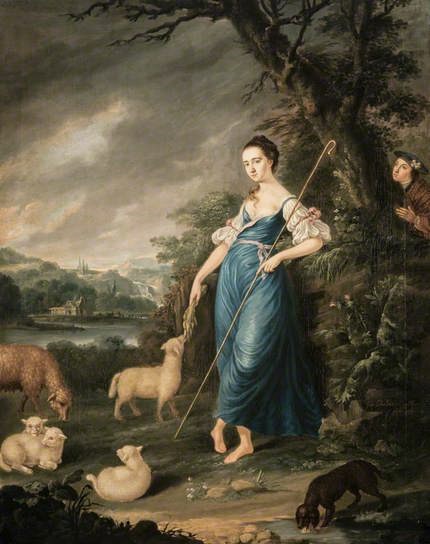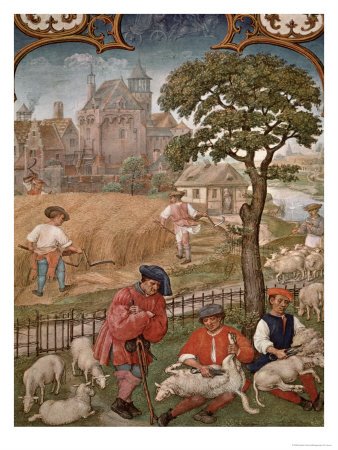In Shepherd’s Songbook I have included both the “pastourelle”(the bucolic songs) of a literal matrix both the pictures of pastoral life, domestic life or traditions related to sheep breeding.
Nel Canzoniere dei Pastori sono incluse sia le Pastorellerie (i canti bucolici) di matrice letterale che i quadri di vita pastorale, vita domestica o di tradizioni relative all’allevamento di ovini.
Shepherd’s Songbook: Pastourelle
The “pastourelle” are the “bucolic” songs very popular in England, Ireland and Scotland in the seventeenth and eighteenth centuries, but already widespread in the Middle Ages by trobadors in the south of France. This literary genre is characterized by the love contrast between a shepherdess and a suitor (also a young shepherd or a gentleman passing through) often with an erotic background or spicy allusive.
In the idyll of a simple but happy rural life, these litterary stories of love and sex are adapted to the city salons, seasoned with humorous jokes and many “euphemisms”. The long verses between the two protagonists are often preliminary to the act of love, with the man in the role of a suitor, and the woman instead more virginal (and sometimes saucy).
From the courtships genere between commoners (which mostly end with cohabitations or weddings), the relationships between the commoner and the gentleman have stereotypical outcomes.
The textual versions are quite similar and describe the same story: a young lord is courting a rustic but very pretty shepherdess guarding her flock.
The song is then developed on the model of love contrast with “call and response” between the parties, with he that is trying to seduce her but she, knowing full well that she would never become his bride, because of their difference in rank that preferreds to escape. In reality the young girls who wandered through the countryside and the woods were easy prey (more or less consensual) of the “hunters” men and often these ballads ended with the announcement of unfortunate pregnancies.
In some cases the two get married, but often the beautiful shepherd girl longs for her moor and life in the open air.
Shepherd’s Songbook: Pastorellerie
Pastorellerie e pastorelle, sono i canti “bucolici” molto popolari in Inghilterra, Irlanda e Scozia nei secoli XVII e XVIII, ma già diffusi nel Medioevo dai trobadori del sud della Francia. Questo genere letterario si caratterizza per il contrasto amoroso tra una pastorella e un corteggiatore (anch’egli pastorello oppure un gentiluomo di passaggio) spesso a sfondo erotico o piccantemente allusivo.
Nell’idillio di una vita agreste semplice ma felice, si innestano queste storielle d’amore e di sesso dal sapore popolare ma più spesso letterario, adattate ai salotti cittadini, condite da battute umoristiche e molti “eufemismi”. I lunghi fraseggi tra i due protagonisti sono spesso dei preliminari all’atto amoroso, con l’uomo nel ruolo di corteggiatore, e la donna invece più ritrosa (anche se non mancano storielle di vogliose pastorelle).
Dal filone dei corteggiamenti tra popolani (che si concludono per lo più con convivenze o matrimoni) si distacca quello tra popolana e gentiluomo con esiti piuttosto stereotipati.
Le versioni testuali sono abbastanza simili e descrivono la stessa storia: mentre una rustica ma assai graziosa pastorella custodisce il gregge, un giovane la spia e la corteggia.
La canzone si sviluppa quindi sul modello di contrasto amoroso con “botta e risposta” tra le parti, con lui che cerca di sedurla e lei che si sottrae, ben sapendo che non potrebbe mai diventare la sua sposa, a causa della loro differenza di rango. In realtà le giovani popolane che si aggiravano per le campagne e i boschi erano ben facili prede (più o meno consensuali) degli uomini “cacciatori” e spesso queste ballate si concludevano con l’annuncio di infauste gravidanze.
In alcuni casi i due convolano a nozze ma spesso la bella pastorella ha nostalgia della sua brughiera sui monti e della vita all’aria aperta.
- (LA) BERGERA
- BLOW AWAY THE MORNING DEW
- BONNY MAY
- BRAW LADS OF GALA WATER
- BROOM OF COWDENKNOWES
- CA’ THE YOWES
- GLASGOW PEGGY
- HEATHER DOWN THE MOOR
- HILLS OF GLENSHEE
- LAIRD OF DRUM
- LASS OF GLENSHEE
- (LA) PASTORA E IL LUPO
- QUEEN AMONG THE HEATHER
- SEARCHING FOR LAMBS
- SHEARING IS NAE FOR YOU
- SHEPERD’S DOCHTER (Child #110)
- (LA) TENTAZIONE (Gentil Galando)
- YOWE LAMB / Lovely Molly

Shepherd’s Songbook: pictures of pastoral life
A.L. Lloyd noted on the original Watersons’ album “Mighty River of Song”: “Shepherds have had an up-and-down time throughout the ages. Once, when wool was England’s main export they were privileged in the village community. Everyone looked up to them for advice and judgement. Later, when agriculture was the big thing, the shepherds sank in prestige (and in wages too!) and in some parts they were reckoned one stage up from tramps. Their songs are proud, tough..”
In Scotland (as in Piedmont) the sheep are brought to the summer pastures on the highlands on the first of May and the shepherds went to live for the whole season in the isolated huts (shielings) next to rivers and ponds. While the men carried the tools they needed to repair the summer huts from the harsh winter, women brought food and kitchen utensils.
The season of courtship began.
Shepherd’s Songbook: quadri di vita pastorale
Scrive A.L Lloyd nella copertina dell’album dei Waterson Mighty River of Song “I pastori hanno avuto alti e bassi nel corso dei secoli. Una volta, quando la lana era la principale esportazione dell’Inghilterra, erano dei privilegiati nella comunità del villaggio. Tutti li cercavano per consigli e giudizi. Più tardi, quando l’agricoltura divenne la cosa più importante, i pastori sprofondarono nel prestigio (e anche nei salari!) e in alcune parti furono considerati ad un gradino più avanti dei vagabondi. Le loro canzoni sono orgogliose, dure..”
In Scozia (come nelle montagne alpine del Piemonte) le pecore venivano portate ai pascoli estivi sugli altopiani il primo di maggio e i pastori andavano a vivere per tutta la stagione nelle isolate malghe (shielings) accanto a fiumi e laghetti. Mentre gli uomini trasportavano gli strumenti necessari per riparare le capanne estive dai danni dell’inverno, le donne portavano cibo e utensili per la cucina.
Iniziava la stagione dei corteggiamenti.

